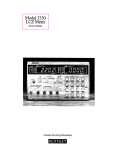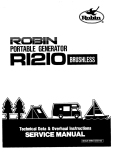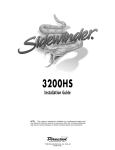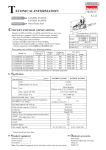Download REGULATORS - The Fly Baby Home Page
Transcript
emy 1 ANDERSON. INDIANA. U.S.A. blMetimn I P - l l 6 A Date 8- 1-60 Page 1 10 Pages SERVICE BULLETIN File Under: R-RELAYS AND REGULATORS STANDARD WATERPROOF REGULATORS (VOLTAGE REGULATOR UNITS WITH ACCELERATOR WINDING) This -bulletin covers Delco-Remy standard threeunit waterproof generator regulators containing an accelerator winding on the voltage regulator unit and having a suffix letter "B" or "C" following the model number. The Delco-Remy three unit regulators illustrated by Fig. 1 are designed for use with generators which have the field circuit insulated in the generator and grounded in the regulator. These regulators differ from those discussed in Bulletin 1R-116 only in design features. Changes in design have altered the routing of the field circuit within the regulator. Methods of adjustment remain basically the same for the regulators described in both bulletins. Regulators covered in this bulletin are most often used on aircraft and 24-volt applications. They include an accelerator or series winding on the voltage regulator unit. Adjusting procedures for this type voltage regulator unit differ from those procedures used on voltage regulator units that do not contain an accelerator or series winding. The regulator shown in Figure 1consists of a cutout relay, a voltage regulator, and a current regulator unit. The cutout relay closes the generator-to-battery circuit when the generator voltage is sufficient to charge the battery, and it opens the circuit when the generator slows down or stops. The voltage regulator unit is a voltage-limiting device that prevents the system voltage from exceeding a specified maximum and thus protects the battery and other voltage-sensitive equipment. The current regulator unit is a current-limiting device that limits the generator output so as not to exceed its rated maximum. Figure 2 is a wiring diagram of this type regulator when the vehicle frame is the ground return. Figure 3 is a wiring diagram of this same type regulator when a wire is the ground return which makes it an insulated or two-wire system. CUTOUT RELAY The cutout relay (Figs. 2 & 3) has two windings, a series winding of a few turns of heavy wire (shown in solid red) and a shunt winding of many turns of fine wire (shown in dashed red). The shunt winding is connected across the generator so that CO: 1.2. 1 W D S b P S . 1.2X. 131. 132: 16. 1FD TERMINAL Figure TERMINAL TERMINAL 1-Delm-Remy three-unit current and voltage regulator with the cover removed. generator voltage is impressed upon it at all times. The series winding is connected in series with the charging circuit so that all generator output passes through it. The relay core and windings are assembled into a frame. A flat steel armature is attached to the frame by a flexible hinge so that it is centered just above the end of the core. The armature contact points are located just above the stationary contact points. When the generator is not operating, the armature contact points are held awax from the stationary points by the tension of a flat spring riveted on the side of the armature. CUTOUT RELAY ACTION-When the generator voltage builds up a value great enough to charge the battery, the magnetism induced by the relay windings is sufficient to pull the armature toward the core so that the contact points close. This completes the circuit between the generator and battery. The current which flows from the generator to the battery passes through the series winding in a direction to add to the magnetism holding the armature down and the contact points closed. When the' generator slows down or stops, current begins to flow from the battery to the generator. PRINTED I N U.S.A. Service BwiBe#iao 1P-116A Page 2 STANDARD REGULATORS BATTERY CUTOUT REUY CURRENT REGUUTOR VOLTAGE REGULATOR AMMETER Figure 2-Wiring circuit of Deleo-Remy grounded type, three-unit regulator shown in Figure 1. The shunt windings in the cutout relay and voltage regulator are shown in dashed rrd, The series windings in the cutout relay and current regulator are shown in solid nd. The series winding i n the voltage regulator h shown in blue. This reverse flow of current through the series winding causes a reversal of the series winding magnetic field. The magnetic field of the shunt winding does not reverse. Therefore, instead of helping each other, the two windings now magnetically oppose so that the resultant magnetic field becomes insufficient to hold the armature down. The flat spring pulls the armature away from the core so that the points separate; this opens the circuit between the generator and battery. VOLTAGE REGULATOR The voltage regulator (Figs. 2 & 3) has two windings assembled on a single core, a shunt winding consisting of many turns of fine wire (shown in dashed red) which is shunted across the generator, and a series winding of a few turns of relatively heavy wire (shown in solid blue) which is connected in series with the generator field circuit when the regulator contact points are closed. The windings and core are assembled into a frame. A flat steel armature is attached to the frame by a flexible hinge so that it is just above the end of the core. The armature contains a contact point which is just beneath a stationary contact point. When the voltage regulator is not operating, the tension of a spiral spring holds the armature away from the core so that the points are in contact and the generator field circuit is completed to ground through them. VOLTAGE REGULATOR ACTION-When the generator voltage reaches the value for which the voltage regulator is adjusted, the magnetic field produced by the two windings (shunt and series) overcomes the armature spring tension and pulls the armature down so that the contact points separate. This inserts resistance into the generator field circuit so that the generator field current and voltage are reduced. Reduction of the generator voltage reduces the magnetic field of the regulator shunt winding. Also, opening the regulator points opens the regulator series winding circuit so that its magnetic field collapses completely. The consequence is that the magnetic field is reduced sufficiently to allow the spiral spring to pull the armature away from the core so that the contact points again close. This directly grounds the generator field circuit so that generator voltage and output increase. The above cycle of action again takes place and the cycle continues at a rate of 50 to 200 times a second, regulating the voltage to a predetermined value. With the voltage thus limited the generator supplies varying amounts of current to meet the varying states of battery charge and electrical load. CURRENT REGULATOR The current regulator (Figs. 2 & 3) has a series winding of a few turns of 'heavy wire (shown in red) which carries all generator output. The winding core is assembled into a frame. A flat steel Page 3 I STANDARD REGULATORS F'iguxe'3--W* Circuit d I)elco-lknv inwkted type, t h r e e - 4 regulator d m i h to that shown in Figme 1. The shunt windings in tbe cutout d a y and vdbge r e g d a k are shown In dahcd red, Tbc series windings in the cutout relay and cur. rent regalator are shown in d i d red. Tbs aeries w h h g in tbe voltage regulator is shown in blue. armature is attached to the frame by a flexible hinge so that it is just above the core. The armature has a contact point which is just below a stationary contact point. When the current regulator is not operating, the t a d o n of a spiral spring holds the m a t u r e away from the core so that the points are in contact. In this position the generator field circuit is completed to ground through the current regulator contact points in series with the voltage regulator contact points. CURRENT REGULATOR ACTION-When the load demands are heavy, as for example, when electrical devices are turned on and the battery is in a discharged condition, the voltage may not increase to a value sufficient to cause the voltage regulator to operate. Consequently, generator output will continue to increase until the generator reaches rated maximum current. This is the current value for which the current regulator is set. Therefore, when the generator reaches rated output, this output, flowing through the current regulator winding, creates sufficient magnetism to pull the current regulator armature down and open the contact points. With the points open, resktance is inserted into the generator field circuit so that the generator output is reduced. As soon as the generator output starts to fall off, the magnetic field of the current regulator winding is reduced, the spiral spring tension pulls the armature up, the contact points close and directly connect the generator field to ground. Output increases and the above cycle is repeated. The cycle continues to take place while the current regulator is in operation 50 to 200 times a second, preventing the generator from exceeding its rated maximum. When the electrical load is reduced (electrical devices turned off or battery comes up to charge), then the voltage increases so that the voltage regulator begins to operate and tapers the generator output down. This prevents the current regulator from operating. Either the voltage regulator or the current regulator operates at any one time-the two do not operate at the same time. RESISTANCES The current and voltage regulator circuits use a common resistor (Figs. 2 & 3) which is inserted in the field circuit when either the current or voltage regulator operates. A second resistor* (Figs. 2 & 3) is connected between the regulator field terminal and the cutout relay frame, which places it in parallel with the generator field coils. The sudden reduction in field current occurring when either the current or voltage regulator contact points open, is accompanied by a surge of induced voltage in the field coils as the strength of the magnetic field changes. These surges are partially dissipated by the two rbsistors, thus preventing excessive arcing at the contact points. *NOTE: The second resistor is not present on all regulators. Many Aircraft regulators have this resistor omitted. Page 4 STANDARD REGULATORS TEMPERATURE COMPENSATION Voltage regulators are compensated for temperature by means of a bimetal thermostatic hinge on the armature. This causes the regulator to regulate at a higher voltage when cold which partly compensates for the fact that a higher voltage is required to charge a cold battery. Many current regulators also have a bimetal thermostatic hinge on the armature. This permits a somewhat higher generator output when the unit is cold, but causes the output to drop off as temperature increases. REGULATOR POLARITY Some regulators are designed for use with negative grounded systems, while other regulators are designed for use with positive grounded systems. Using the wrong polarity regulator on an installation will cause the regulator contact points to pit badly and give short life. As a safeguard against installation of the wrong polarity regulator, all regulators of this type have the model number and the polarity clearly stamped on the end of the regulator base. REG'ULATOR MAINTENANCE GENERAL INSTRUCTIONS 1. Mechanical checks and adjustments (air gaps, point opening) must be made with battery disconnected and regulator preferably off the vehicle. CAUTION: The cutout relay contact points must never be closed by hand with the battery connected to the regulator. This would cause a high current to flow through the units which would seriously damage them. 2. Electrical checks and adjustments may be made either on or off the vehicle. The regulator must always be operated with the type generator for which it is designed. 3. The regulator must be mounted in the operating position when electrical settings are checked and adjusted and it must be at operating temperatwe.* *Operating temperature for voltage regulator checking and adjusting is reached after 15 minutes of continuous operation of the voltage regulator unit, with the regulator cover in place and the proper resistor in series with the generator. For proper resistance values, see the "Voltage Setting" procedure under the "Regulator Checks and Adjustments" section. It is not necessary to measure the amount of current flowing during . warm-up or testing of the voltage unit; however, it is important that no electrical load other than ignition be turned on during the test. (If a variable resistor is used in series with the battery, set to 1-10 amperes for warm-up period.) Operating temperature for temperature-compensated current regulators is reached after 15.minutes of operation with current regulator operating and cover in place. (Noncompensated current regulators operate the same, hot or cold. Operating temperature, therefore, may be disregarded.) 4. Specified generator speeds for testing and adjusting. a. Voltage Regulator (1) For passenger cars and trucks, 3,500 generator r.p.m. (2) Operating speed for constant speed engines (light aircraft engines included in this classification). (3) Governed speed for govenied engines. b. Current Regulator (1) All generators must be operated at a speed sufficient to produce current in excess of specified setting. (2) Voltage of the generator must be kept high enough to insure sufficient current output, but below the operating voltage of the voltage regulator unit. 5. After any tests or adjustments the generator on the vehicle must be polarized after leads are connected, but before the engine is started, as follows: POLARIZING GENERATOR After reconnecting leads, momentarily connect a jumper lead between the "GEN" and "BAT" terminals of the regulator. This allows a momentary surge of current to flow through the generator which correctly polarizes it. Failure to do this may result in severe damage to the equipment since reversed polarity causes vibration, arcing, and burning of the relay contact points. CAUTION: If a fuse is located on the regulator, polarize the generator by momentarily placing a jumper between the "GEN" terminal and the screw on the fuse to which the lead is connected. If the other screw on the fuse is touched, the fuse may blow. . Page 5 STANDARD REGULATORS QUICK CHECKS OF GENERATOR AND REGULATOR +a- In analyzing complaints of generator-regulator operation, any of several basic conditions may be found. HIGH w CHARGING RATE NOR$AL DISCHARGED (3) Low Battery and High Charging Rate-This tzQ- is normal generator-regulator action Regulator settings may be checked as outlined in the fol- I lowing section. LOW CHARGING RATE NOF~GAL #b FULLY CHARGED (1) Fully Charged Battery and Low Charging Rate-This indicates normal generator-regulator operation. Regulator settings may be checked as outlined in the following section. + -- I I HlGH CHARGING RATE FULLY CHARGED (2) Fully Charged Battery and a High Charging Rate--% indicates that the voltage regulator is not reducing the generator output as it should. A high charging rate to a fully charged battery will damage the battery and the accompanying high voltage is very injurious to all electrical units. This operating condition may result from: (a) Improper voltage regulator setting. (b) Defective voltage regulator unit. (c) Grounded generator field circuit (in either generator, regulator or wiring). (d) Poor ground connection at regulator and high speed operation. (e) High temperature which reduces the resistance of the battery to charge so that it will accept a high charging rate even though the voltage regulator setting is normal. If the trouble is not due to high temperature, determine the cause of trouble by disconnecting the lead from the regulator "F" terminal with the generator operating at medium speed. If the output remains high, the generator field is grounded either in the generator (see Service Bulletin 1G-150) or in the wiring harness. If the output drops off the regulator is at fault and it should be checked for a high voltage setting or grounds and poor ground connections. I DISCHARGED - LOW OR NO CHARGING RATE UNDERCHARGING w w (4) Low Battery and Low or No Charging Rate-This condition could be due to: (a) Loose connections or damaged wires. (b) Defective battery. (c) High circuit resistance. (d) Low regulator setting. (e) Oxidized regulator contact points. (f) Defects within the generator. If the condition is not caused by loose connections or damaged wires, proceed as follows to locate cause of trouble. To determine whether the generator or regulator is at fault, momentarily ground the "F" terminal of the regulator and increase generator speed. If the output does not increase, the generator is probably at fault and it should be checked as outlined in Service Bulletin 1G-150. If the generator output increases, the trouble is due to: (a) A low voltage (or current) regulator setting. (b) Oxidized regulator contact points which insert excessive resistance into the generator field circuit so that output remains low. (c) Generator field circuit open within the regulator at the connections or in the regulator winding. (5) Burned Resistances, Windings or ContactsThese result from open circuit operation, open resistance units, or high resistance in the charging circuit. Where burned resistances, windings or contacts are found, always check car wiring before installing a new regulator. Otherwise, the new regulator may also fail in the same way. (6) Burned Relay Contact Points-This may be due to reversed generator polarity. Generator polarity must be corrected as explained on page 4 after any checks of the regulator or generator, or after disconnecting and reconnecting leads. Page 6 STANDARD REGULATORS CLEANING CONTACT POINTS The contact points of a regulator will not operate indefinitely without same attention It has been found that a great majority of all regulator trouble can be eliminated by a simple cleaning of the contact points, plus some possible readjustment. The flat points should be cleaned with a spoon or m e r file. On negative grounded regulators which have the flat contact point on the regulator armatures, loosen the contact bracket mounting screws so that the bracket can be tilted to one side (Fig. 5). On positive grounded regulators, the flat point is in the upper contact bracket so the bracket must be removed for cleaning the points. A flat file cannot be used successfully to clean the flat contact points since it will not touch the center of the flat point where point wear is most apt to occur. NEVER USE EMERY CLOTH OR SANDPAPEZt TO CLEAN THE CONTACT POINTS. Remove all the oxides from the contact points but note that it is not necessary to remove &y cavity that may have developed. S P O O N OR RJFFLER FILE \ - --ry .. TO CLEAN CONTACT POINTS (LOOSEN UPPER CONTACT BRACKET MOUNTING SCREWS) ADAPTING VOLTAGE REGULATOR SETIWG FOR UNUSUAL CONDITIONS m m The voltage regulator setting at times may need to be "tailored" to adapt it to the battery and type of service. The ideal setting is that which will keep the battery at or near full charge with minimum use of water. The "normal" setting (value shown in test specifications) usually will be satisfactory for average service. However, if service is above or below average, the setting must be tailored to fit the job. Either of two conditions which may exist will require tailoring: (1) battery is being overcharged (using too much water), (2) battery remains undercharged (3A charge or less). Corrections may be made as follows: (1) If battery uses too much water at normal setting, reduce voltage setting 0.1 or 0.2 of a volt and check for improved condition over a reasonable service.period. Repeat until battery remains charged with a minimum use of water. It rarely will be necessary to go below 13.8 volts on a 12-volt system or 6.9 volts on a &volt system or 27.6 volts on a 24-volt system. CAUTION: Whenever the voltage setting is reduced, the cutout relay must also be checked and reduced if necessary. It must be at least 0.5 of a volt less than voltage regulator setting. (2) If battery is consistently undercharged at normal setting, increase the voltage setting 0.1 of a volt and check for improved condition over a reasonable service period. Repeat until the battery remains charged with a minimum use of water. It rarely will be necessary to increase the voltage above 14.8 on a 12-volt system or 7.5 volts on a &volt system or 29.6 volts on a 24-volt system. CAUTION: When increasing voltage avoid settings high enough to damage lights or other voltagesensitive equipment during cold weather operation. Before tailoring the voltage setting for unusual c o n d i t k m be sure the battery is normal-not sulfated, not permanently damaged due to having been overheated, not operating in too hot a location, and not poorly ventilated. &Ulw&ating use of spoon or rimer file to clean flat eontact points in regulator. REGULATOR CHECKS AND ADJUSTMENTS (See Delco-Remy Service Bulletins lR-180, lR185, or 1R-186 for Specifications.) Procedure: For best results, the following steps should be taken in the sequence given: (1) Bring voltage regulator to operating temperature, (2) Check voltage regulator, (3) Check cutout relay. (4) Bring current regulator to operating temperature, (5) Check current regulator. VOLTAGE REGULATOR Two checks and adjustments are required on the voltage regulator, air gap and voltage setting. Air G a p t o check air gap, push armature down until the contact points are just touching and then measure air gap (Fig. 5). Adjust by loosening the contact mounting screws and raising or lowering contact bracket as required. Be sure the points are lined up and tighten screws after adjustment. Voltage Setting-There are two ways to check the voltage setting-the heed resistance method and the variable resistance method (Figs. 6 and 8). :: j~ Page 7 STANDARD REGULATORS Fixed Resistance Method1. Connect a fixed resistance between the battery terminal and ground as shown in Fig. 6 after disconnecting the battery lead from the battery terminal of the regulator. The resistance must be 3/4 ohm* for &volt units, 1%ohms* for 12 volt units, 7 ohms for 24volt units. It must be capable of carrying 10 amperes for 6- and 12 volt systems, 6 7 amperes for 24-volt systems, without any change of resistance with temperature changes. *NOTE:With all 6-volt regulators having current ratings less than 15 amperes, it is necwary to use a 1%ohm h e d resistance to avoid interference from the current regulator. With all 12-volt regulators having current ratings less than 15 amperes, a 2%-ohm fixed resistance (%-ohm and 1%ohm resistors in series) must be used for the same reason. 2. Connect a voltmeter from regulator "BAT' terminal to ground. Method ELConnect a variable resistance into the field circuit, as in Figure 6. Turn out all resistance. Operate generator at specified speed. Slowly increase (turn in) resistance until generator voltage is reduced to 2 volts on a &volt system, 4 volts on a 12-volt system or 6 volts on a 24-volt system. Turn out all resistance again, and note voltage setting (with voltmeter connected as in Figure 6). Regulator cover must be in place. 6. Note the thermometer reading and select the Normal Range of Voltage for this temperature as W in specifications 1R-180, 1R-185, 1R186. AIR GAP (CHECK WITH POINTS -2 OHM-12 VOLT OHM--24 VOLT Figure &Fixed resistance and voltmeter connections to check voltage regulator setting by fixed resistance method. F'ixed resistance leads shown in red and voltmeter lea& shown in blue. Variable resistance may be connected as shown for cycling generator. MOUNTING SCREWS (LOOSEN T O SET AIR GAP) ~ y r 5--Voltage e regulator air Z~P check and 4-t 7. Note the voltmeter reading with regulator cover in place. 3. Place the thermometer within % inch of regulator cover to measure regulator ambient temperature. 8. To adjust voltage setting turn adjusting screw (Fig. 7). Turn clockwise to increase setting and counterwise to decrease voltage setting. 4. Operate generator at specified speed for 15 minutes with regulator cover in place to bring the voltage regulator to operating temperature. CAUTION: If adjusting screw is turned down (clockwise) beyond range, spring support may not return when screw is backed off. In such case, turn screw counterclockwise until there is ample clearance between screw head and spring support. Then bend spring support up carefully until it touches the screw head. Final setting of the unit .should always be made by increasing spring tension, never by reducing it. If setting is too high adjust unit below required value and then raise to exact setting by increasing the spring tension. After each adjustment and before taking reading replace the regulator cover and cycle the generator. 5. Cycle the generator: Method A-Move voltmeter lead from "BAT" to "GEN" terminal of regulator. Retard generator speed until generator voltage is reduced to 2 volts on a &volt system, or 4 volts on a 12-volt system or 6 volts on a 24volt system, Move voltmeter lead back to "BAT" terminal of regulator. Bring generator back to specified speed, and note voltage setting. Se~lriceBaa%ie.fba1P-136A Page 8 STANDARD REGULATORS *-. &) 2 V, ADJUSTING SCREW (TURN TO ADJUST SETTING) 3. Place thermometer within 4/4 inch of regulator cover to measure regulator ambient tempera- ture. 4. Operate generator at spe&ed speed. Adjust variable resistor until current flow is 8-10 amperes ( 4 6 amperes on 6- and 12-volt generators having current ratings of less than 15 amperes). If less current than is required above is flowing it will be necessary to turn on vehicle lights to permit increased generator output. Variable resistance can then be used to decrease current flow to the required amount. Allow generator to operate at this speed and current flow for 15 minutes with regulator cover in place in order to bring the voltage . regulator to operating temperature. Figure 7-Adjusting voltam ryPLQr actthy. Variable Resistance Method1. Connect ammeter and % ohm variable resistor in series with the battery a s shown in Figure 8. NOTE-It is very important that the variable resistance be connected at the "BAT" terminal as shown in Figure 6 rather than at the "GEN" termid, even though these terminals are in the same circuit. An examination of the wiring diagram, Figures 2 and 3, will show that -tion begins at the point where the shunt winare connected to the series circuit. Any small resktance added to the circuit between the generator and this point will simply be offset by a rise in generator voltage without atlectiug the output shown at the ammeter. 2. Connect Voltmetej between "BAT' tenninal and ground. : 5. Cycle the generator by either method listed in Step 5 of "Fixed Resistance Method" of "Voltage Setting" procedure. 6. Note the thermometer reading and select the " N o d Range" of voltage for this temperature as listed in specitications lR-180, lR-185, or 1R186. 7. Note the voltmeter reading with regulator cover in place. 8. Adjust voltage regulator as reguired as described in Step 8 of "Fixed Resistance Method" of "Voltage Setting Procedure." In using the variable resistance method, it is necessary to readjust the variable resistance after each voltage adjustment to assure that 8-10 amperes are flowing (4-6 amperes on low output units). Cycle generator after each adjustment before reading voltage regulator setting with cover in place. CUTOUT RELAY The cutout relay requires three checks and ad-. justments: air gap, point opening, and closing voltage. The air gap and point opening adjustments must be made with the battery disconnected. AIR GAP-Place fingers on armature directly above core and move armature down until points just close and then measure air gap between armature and center of core (Fig. 9). On multiple contact point relays, make sure that all points close simultaneously. If they do not, bend spring h g e r so they do. To adjust air gap, loosen two screws at the back of relay and raise or lower the armature as required. Tighten screws after adjustment. POINT OPENING-Check point opening and adammeter and variable redstance eonneetiom for checking voltage ngalptor seUiug by the variable redstance method. Variable nsishnce and ammeter leads shown in red and voltmeter h d s in blue Figure &Voltmeter, just by bending the upper armature stop (Fig. 10). Closing Voltage-1. Connect regulator to proper generator a d bat- Service Bulletin 1W-116A Page 9 STANDARD REGULATORS tery. Connect voltmeter between the regulator "GEN" terminal and ground. (Fig. 11). VARIABLE RESISTANCE 2. Method A--Slowly increase generator speed and note relay closing voltage. Decrease generator speed and make sure the cutout relay points open. Figure 11-Voltmeter conneetiom to cheek cutout relay dosh g voltage.. Variable resistance may be connected as shown for cycling generator. ADJUSTING SCREWS (LOOSEN TO SET AIR GAP) ~igure W u t o u t relay air gap check and a d M m = t Battul must be disconnected whm this check is made. Method B-Make connections as in Step 1,but in addition add a variable resistor connected If UPPER ARMATURE STOP (BEND 10 ADJUST POINT OPENING) Figure IO-Cutout relay point opening check and adjustment. Battery must be disconnected when this check is made into the field circuit (Fig. 11).Use a 15 ohm-25 watt resistor for 6-volt systems, or 25 ohm-25 watt resistor for 12- and 24-volt systems. Operate generator at medium speed with variable resistance turned all in. Slowly decrease (turn out) the resistance until cutout relay points close. Note closing voltage. With cover in place slowly increase (turn in) resistance to make sure points open. 3. Adjust closing voltage (either method) by turning adjusting screw (Fig. 12). Turn screw clockwise to increase setting and counterclockwise to decrease setting. Figure 12-Adjustment of cutout relay closing voltage. Service BuBSetim 1P-dl6A Page 10 STANDARD REGULATORS - -- CURRENT REGULATOR Two checks and adjustments are required on the current regulator: ai-r gap and current setting. R I W T m - JUMPER LEAD BRIDGING VOLTAGE REGULATOR CONTACT POINTS Air Gap-Check and adjust in exactly the same manner as for the voltage regulator. Current Setting-Current regulator setting on current regulators having temperature compensation should be checked by the following method: LOAD METHOD1. Connect ammeter into charging circuit, as in Figure 13. 2. Turn on all accessory load (lights, radio, .etc.) and connect an additional load across the battery (such as a carbon pile or bank of lights) so as to drop the system voltage approximately one volt below the voltage regulator setting. 3. Operate generator at specified speed for 15 minutes with cover in pLace. (This establishes operating temperature; see paragraphs 3 and 4 in General Instructions.) If current regulator is not temperature-compensated, disregard 15-minute warm-up period. AMMmR GENERATOR Figure 1CAmmeter and jumper lead connections for checking cumnt regulator setting by jumper lead method. Ammeter leads and jumper leads shown in red. (Only for current regulators without temperature compensation) 4. Cycle generator and note current setting. 2. Connect jumper lead across voltage regulator points, as in Figure 14. 5. Adjust in same manner as described for the voltage regulator (Fig. 7). 3. Turn on all lights and accessories or load battery as in "2" under Load Method. 4. Operate generator at specified speed and note current setting. 5. Adjust in same manner as described for the voltage regulator (Fig. 7). REPAIR SECTION REGULATOR SPRING REPLACEMENT If it becames necessary to replace the spiral spring on either the current or voltage regulator unit, the new spring should first be hooked on the lower spring support and then stretched up until it can be hooked at the upper end. Stretch the spring only by means of a screwdriver blade inserted between the turns (or in a similar manner)--do not pry the spring into place, as this is likely to bend the spring support. After installing a new spring, readjust the unit setting as already described. RADIO BY-PASS CONDENSERS Figure 13--Connections for checking cumnt regulator by load method. JUMPER LEAD METHOD-(Use only for current regulators without temperature compensation.) 1. Connect ammeter into charging circuit, as in Figure 14. The installation of radio by-pass condensers on the field terminal of the regulator or generator will cause the regulator contact points to burn and oxidize so that generator output will be reduced and a rundown battery will result. If a condenser is found connected to either of these terminals, disconnect the condenser and clean the regulator contact points as previously explained.




















